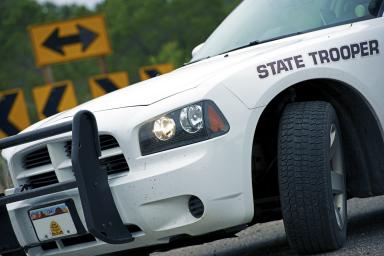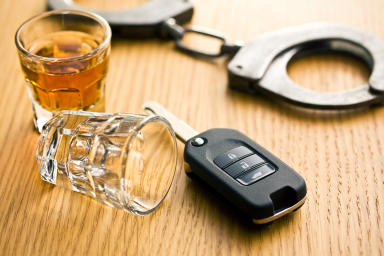Connecticut DUI Laws

According to a 2021 report by the National Highway Traffic Safety Administration, there were 13,384 fatalities in motor vehicle crashes, representing 31% of all traffic-related deaths in the U.S. for that year. In Connecticut, there were 112 alcohol-impaired driving fatalities in accidents involving BAC levels of 0.08% or higher, which accounted for 38% of all motor vehicle traffic-related deaths in the state. NHTSA also reported 73 alcohol-impaired driving fatalities in crashes involving BAC levels of 0.15% or more.
By law, operating a motor vehicle while under the influence of alcohol and/or drugs in Connecticut is a criminal offense. A first conviction is a misdemeanor, while a second or subsequent one constitutes a felony. In the case of State of Connecticut vs. Haight, the court ruled that “operating a motor vehicle” is not confined to driving and includes any act that, alone or in sequence, would set the vehicle in motion, such as inserting the key into the ignition. The state’s OUI laws are further explained in Connecticut General Statutes § 14-227a and 14-227b. An OUI arrest in Connecticut involves two separate actions: a criminal case in the Superior Court and an administrative per se license suspension proceeding at the DMV.
The following sections provide an overview of OUI statutes, criminal penalties, administrative sanctions, related laws, and resources for offenders and victims.
Operating Under the Influence in Connecticut
In Connecticut, the preferred term for criminal charges related to alcohol- or drug-impaired driving is operating under the influence, or OUI. Regardless of the terminology used, the court treats a DUI offense that occurs out-of-state the same as an OUI in Connecticut. A driver with a prior conviction in another state could be arrested for OUI as a second or subsequent offense in Connecticut.
CGS § 14-227a prohibits an operator from driving (1) while under the influence of alcohol, drugs, or both, or (2) with an elevated blood alcohol content. The law applies to drivers operating motor vehicles anywhere, including their own property, and to those operating all-terrain vehicles and snowmobiles. The statutes make it illegal for a person over the age of 21 to have a BAC of 0.08% or more and for those operating a commercial motor vehicle to test a BAC of 0.04% or above.
Connecticut’s Implied Consent Law
CGS § 14-227b provides that anyone who drives in the state is deemed to have consented to a chemical test of their blood, breath, or urine. If the driver is a minor, their parents or guardians are considered to have given their consent. The Department of Motor Vehicles imposes an administrative license suspension on operators who refuse to submit to a test or whose results indicate an elevated BAC.
Under CGS § 14-227c, a person must submit to an alcohol test if their vehicle is involved in an accident that caused a serious physical injury or death of another, and the police officer has probable cause to believe that the individual was driving under the influence.
A key difference in arresting someone for OUI in Connecticut is that, although the law allows administrative license suspension for a driver who refuses to submit to a test or has an elevated BAC, the law currently does not place a limit on the volume of drugs, including medical marijuana, that motorists may have in their bloodstream while driving. Any quantity of it in a sample or other evidence of drug-impaired driving, such as the observations of a law enforcement officer, may be sufficient to support a person’s conviction.
Connecticut’s Zero Tolerance Law
For individuals younger than 21, CGS § 14-227g, or the zero tolerance law, sets the legal BAC limit at 0.02%. An underage driver who uses a fake identification or makes false statements in an attempt to buy alcohol can be charged with misrepresentation of age to procure liquor under CGS § 30-88a. However, the law does not apply to minors having liquor on a physician’s orders and those in the company of their parents, guardians, or spouse, as well as a liquor permittee and their employees.
CGS § 30-89a also states that anyone who knowingly or recklessly permits someone under 21 to illegally possess alcohol or fails to make a reasonable effort to halt such possession may be liable for a drunk driving accident caused by the minor. Driving under the influence without a license as a minor is an aggravating factor, which could upgrade a misdemeanor OUI to a felony offense. It is also illegal for any individual, including those under 21, to drive under the influence of drugs, even though Connecticut has legalized the recreational use of marijuana.
OUI with Minor Passengers in Connecticut
Under CGS § 14-227m, it is illegal for someone drunk or high to operate a motor vehicle with a child under 18 as a passenger. CGS § 14-227n also prohibits an intoxicated individual from operating a school bus or other vehicles specially designated for carrying children.
If the driver has a child under the age of 16 as a passenger, they may be charged with risk of injury to a minor under CGS § 53-21, in addition to any penalty the motorist receives upon conviction of OUI. Regardless of the victim’s age, a person who causes a serious physical injury or death of another could also face charges of second-degree assault or second-degree manslaughter with a motor vehicle, respectively, under CGS §§ 53a-60d and 53a-56b.
What Are the Penalties for a DUI in Connecticut?
A driver convicted of OUI is subject to criminal penalties. Connecticut laws establish a 10-year lookback period to determine if a person has a prior OUI conviction and impose more stringent penalties for repeat offenders.
First DUI Offense
For a first conviction, the penalties are:
Either (1) up to a six-month prison sentence with a mandatory minimum of two days or (2) up to six months in prison with probation requiring 100 hours of community service.
$500 to $1,000 in fines.
A 45-day license suspension, followed by one year of driving only a vehicle equipped with an ignition interlock.
An ignition interlock device, or IID, prevents a driver from operating a vehicle if their BAC exceeds the threshold.
Second DUI Offense
For a second offense, drivers will face:
Up to two years in prison with a mandatory minimum of 120 consecutive days and probation with 100 hours of community service.
$1,000 to $4,000 in fines.
A license suspension for 45 days or until the offender turns 21, followed by three years of driving with an ignition interlock.
For the first year, a second-time offender can only drive to and from probation appointments, alcohol or drug treatment programs, ignition interlock service centers, school, or work.
Third or Subsequent DUI Offense
For a third or subsequent one, the penalties include:
Up to three years in prison with a mandatory minimum of one year and probation with 100 hours of community service.
$2,000 to $8,000 in fines.
License revocation.
The offender is eligible for reinstatement after two years. If reinstated, they must drive only interlock-equipped vehicles for as long as they drive. After 15 years, the commissioner may lift the requirement after a hearing and for good cause.
Additionally, for second or subsequent OUI convictions, the law requires an offender to (1) submit to an alcohol or drug abuse assessment through the Court Support Services Division and (2) undergo a treatment program if ordered by the court.
If an individual is sentenced to probation, the court may also require, as a condition, that the offender take part in a victim impact panel program approved by CSSD. The panel provides a non-confrontational forum for victims and offenders to share experiences on the impact of alcohol- or drug-related incidents on their lives.
Underage OUI Penalties
For a first offense, a minor could face up to six months in jail, $500 to $1,000 in fines, probation, a 45-day license suspension, and a requirement to install an IID for one year.
For a second conviction within the 10-year lookback period, an underage driver could face up to two years in prison, $1,000 to $4,000 in fines, probation, a 45-day license suspension, and a requirement to install an IID for three years.
For a third or subsequent offense, an offender could be sentenced to up to three years in prison and face $2,000 to $8,000 in fines, probation, and permanent license revocation with the possibility of reinstatement.
Additionally, the period for license suspension increases significantly based on the underage operator’s BAC level. If a minor arrested for OUI has a BAC of 0.02% to 0.08%, their license could be suspended for six months. However, if an offender has a BAC greater than 0.08%, the suspension could be for an entire year.
Connecticut’s Dram Shop Law
CGS § 30-102, or the Dram Shop Act, also authorizes a cause of action against a vendor or their employee who sells alcohol to a visibly or perceivably intoxicated individual who thereafter injures another person or property.
In relation to the aforementioned statute, CGS § 30-86 specifically prohibits a permitee from selling liquor to three classes of persons: (1) minors, (2) intoxicated persons, and (3) habitual drunkards. In the case of Craig v. Driscoll (2003), the Appellate Court reasoned that alcoholics, like minors, are a separate class of persons who are unable to deal responsibly with the effects of liquor. The act of serving alcohol to an obviously intoxicated person by someone who knows or reasonably should know that the patron intends to operate a motor vehicle upon leaving creates a foreseeable risk of injury to others on the roadways. It reflects wanton or reckless misconduct and is sufficient to state a negligence cause of action. The court defined “wanton or reckless misconduct” as conduct that indicates a reckless disregard of the rights or safety of others.
As a response to Craig v. Driscoll, the Connecticut Legislature repealed and reenacted the Dram Shop Act in 2003 and later passed Public Act No. 03-91, prohibiting negligence cause of action against a vendor for the sale of alcohol to a person over the age of 21. The court sets the damages a seller must pay up to $250,000. The injured person must bring the lawsuit within one year of the sale.
A dram shop may limit its liability by implementing practices to prevent already intoxicated customers from being served alcohol, such as by training employees in liquor service programs from ServSafe, Techniques of Alcohol Management, and Training for Intervention Procedures. It may also obtain liquor liability insurance to protect itself from the risks of alcohol-related incidents, including OUI. However, if the sale was made to someone under 21, the insurance coverage cannot protect the seller. As mentioned previously, CGS § 30-86 prohibits any individual from selling or giving alcohol to a minor by any means, including but not limited to the Internet.
How Much Can Someone Sue for a Drunk Driving Injury in Connecticut?
A civil action for damages may also be brought against a person who operates a motor vehicle while intoxicated and causes the death of a passenger in an accident. A plaintiff must prove the nature and extent of the loss or injury and that the driver’s negligence was the proximate cause.
An operator could be liable for (1) economic damages, such as income loss, medical costs, and funeral expenses, and (2) non-economic damages covering physical pain, suffering, and loss of enjoyment of life. They could also be liable to a surviving spouse in a loss of consortium claim.
CGS § 14-295 authorizes double or triple damages in a civil action if (1) the accused deliberately or with reckless disregard operated a motor vehicle in violation of the drunk driving law and (2) such violation was a substantial factor in causing injury, death, or property damage.
The state follows the modified comparative negligence rule, which reduces the damages a plaintiff may recover in proportion to their percentage of fault. If a person is found to be more than 50% responsible for an OUI accident, they will be barred from recovery. To establish a driver’s liability, a plaintiff must prove that (1) the defendant owed a duty of care, (2) the person breached the duty by acting negligently, (3) the breach of duty caused the injuries, and (4) the injured party suffered damages as a result of the OUI accident.
The Statute of Limitations in Connecticut
Under CGS § 52-584, the statute of limitations for filing a lawsuit is two years from the date when the victim first sustained or discovered the injury. In wrongful death cases, the administrator or executor of a decedent’s estate must bring an action against the liable driver within two years from the date of death. After the two-year period, a plaintiff forfeits their right to file a lawsuit and recover damages. However, one can bring an action at any time if the person at fault for injuries resulting in death is convicted or found not guilty by reason of mental disease or defect in homicide crimes.
In the case of a minor plaintiff, Connecticut does not extend the statute of limitations under any circumstances. The state sets three years from the date of the accident as the absolute time limit for filing an OUI-related personal injury lawsuit.
Resources for DUI Defendants and Folks Injured by an Impaired Driver in Connecticut
At present, OUI remains a concerning issue that affects people in Connecticut, especially when it results in injury or death from accidents. According to the NHTSA, one alcohol-impaired driving fatality occurred every 39 minutes on average in the U.S. in 2021. However, such situations can be prevented by increasing public awareness of the prevalence and risks of drunk and/or drug-impaired driving and equipping people with the resources to address them.
This section describes three programs by different organizations that aim to educate and support individuals affected by alcohol- and other substance-abuse-related OUI incidents in Connecticut.
Power of Parents and Power of You(th)
The Power of Parents and Power of You(th) are programs by Nationwide Insurance in partnership with Mothers Against Drunk Driving Connecticut, a nonprofit organization that works to end alcohol- and drug-impaired driving. A significant program component is the Parent Pledge, which empowers parents and middle and high school teens to have ongoing conversations about the dangers of underage drinking and drug use. A person can obtain downloadable resources, such as digital handbooks about parenting, and participate in awareness campaigns, open dialogues, and workshops by visiting the website.
E3: Engage, Encourage, Empower
E3: Engage, Encourage, Empower is an initiative by the Governor’s Prevention Partnership that addresses drinking and substance use among teens in Connecticut through the transformative power of peer-to-peer prevention. The program, led by trained high school students, helps the youth learn about the harms of such a lifestyle and develop the skills they need for healthy decision-making through a 12-module educational curriculum on character development and leadership opportunities. It is delivered in person or virtually. To participate in the program, a person may contact the program manager, Jessica White, at jessica@preventionworksct.org.
Victims of Crime Act Case Management Program
The VOCA Case Management Program is a project funded in part by a grant from the U.S. Department of Justice, Office for Victims of Crime that supports the personal growth and emotional healing of victims of crimes, such as OUI, through advocacy, assistance with the compensation process, and crisis intervention and safety planning. It also provides resources on childcare, counseling, housing assistance, and transportation. One may visit LifeBridge Community Services in Connecticut to apply for the program. They may self-refer by calling 1-800-505-9000 or completing the online intake form.
Expertise.com StaffAuthor
Step into the world of Expertise.com, your go-to hub for credible insights. We don't take accuracy lightly around here. Our squad of expert reviewers, each a maestro in their field, has given the green light to every single article you'll find. From rigorous fact-checking to meticulous evaluations of service providers, we've got it all covered. So feel free to dive in and explore. The information you'll uncover has been stamped with the seal of approval by our top-notch experts.




